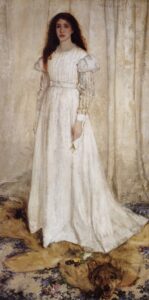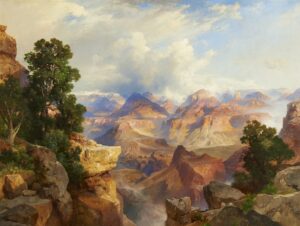
“Boston Buffalo Trail”
Too many artists confuse marketing with advertising and, in my opinion, it’s not the same as advertising at all. Sure we are trying to sell paintings, but I think marketing can be about showing the world who we are and why we do what we do. The “artist” is very much a part of what the collector is buying just as much as the artwork. Marketing is purely about creating value and connection, there should be no shame in that. My primary concern is what can I create that will bring value to someone else and how can I get that to them or find those who desire this value and connection.

“I See Your Face on Every Flower”
For example, Albert Bierstadt was known to charge admission for a theatrical revealing of new paintings. He, like Frederic Church, would include artifacts, plant life, and even (although politically incorrect now) hired Native Americans to be at the showing. What a way to draw attention to your work! Bierstadt also travelled with a celebrated writer, Fitz Ludlow, who later published a book about their adventures. He was also successful at cultivating his own important patrons and promoting his work.
Thomas Moran was a self-proclaimed romantic but a shrewd businessman keenly attuned to the market. Moran said that he secured 100 commission contracts before even traveling to the Grand Canyon. Like Bierstadt, he too would arrange press releases and showings of his work in venues that would garner the most prominence and prestige.

“White number 1 The White Girl” 1862
A completely different artist, James McNeill Whistler, would notoriously throw himself into the public eye. He wrote the local press often about his work and would combat with critics, keeping his work in the news longer. He hosted collector’s brunches where he would entertain his patrons hoping to secure future sales and commissions. He would even write his own memoir, The Gentle art of Making Enemies, and another with his thoughts about art, Ten O’clock. Whistler might be seen as one of the first artists to brand themselves by using a butterfly as his signature.
Obviously we can go on and on with examples all the way back to Michelangelo, who notoriously added his name (branding!) to the Pieta when the crowds gave credit to another sculptor, assuring his future commissions. The point is that all of these artists adapted to the ways of their time and put themselves out there by both self-promoting and aligning with others to promote their work. These tidbit examples are a small but crucial part of their artistic lives. The quality of their work did not suffer because they promoted themselves and in fact one could say because they promoted themselves they afforded the opportunity to create and leave quality work behind for the rest of us. I believe that if marketing was imperative back then, it should be even more so today with a highly saturated art market.
I challenge artists to question their beliefs and fears around marketing. What is holding you back? What judgments do you have and are they serving you? If you were to put yourself out there what kind of rewards might you see? Who might you bring value to? Can you shift the way you look at marketing? Who are you afraid of offending?

“Grand Canyon”
Gilcrease Museum
There are so many ways that you can get started marketing today. You can do it by email, in person, in magazines, and various print and social media, to name a few. First, I encourage you to get to the bottom of why you’re not marketing and then think about how you can start marketing. If you don’t know how to do something, well there’s a book, a blog, a video, an online course, a coach, or someone you can hire for that. Your subsequent artistic career depends on it so get started today!
My Experience With A 100 Day Challenge

by Kelli Folsom
At the time I was exhausted, feeling stagnate getting burned out. Part of my exhaustion was due to overworking, teaching too much and primarily doing some teaching that was not a good fit for me at a local University for two semesters which was leaving me with strained studio time. So as I was doing my usual digging on the internet for new ideas, I wound up stumbling upon someone’s blog…. don’t remember whose now, you know how that goes. She gave a long list of resources some of which I had read and just weren’t for me and at the end, she mentioned this program called the 100 Day Challenge. I went and checked out the site and listened to some interviews with the creator on YouTube. I felt this instinct saying, “you need to try this.”
The Challenge started before tax time and before my 2nd semester of teaching was over. “Not exactly the right time since I’m totally frazzled,” I thought. Excuses, excuses…here they came. The second excuse: it costs $200. A third excuse: this is just motivational hype…. and more and more fear, panic and what will people think of me bull hockey. So, I signed up. I thought, what’s the worst that can happen? I lose $200. What’s the best that can happen? I learn some powerful lessons that actually change the course of things. BINGO. SIGN ME UP.
I signed up and kept it secret for quite a while afraid of judgments against it. Now that it is over I can happily report that it was an incredible experience – not easy, but incredible. Therefore, I STRONGLY recommend the program to anyone who wants to see some changes in their life – in any area. This is not just for artists or entrepreneurs; it’s for everyone. It’s not just to make money or lose weight; it can be for developing mindfulness or spending more time with your family or any area in which you would like to see dramatic growth. The program is designed to walk you through any goal and keep you motivated while working on it. You are the one that makes it happen though, by taking action and following through. So now I will share what my particular goal and experience was.
Disclosure: If you have weird beliefs about making money or are too much of an idealist and think that you should be a starving artist, READ NO FURTHER.
My goal happened to be a painting sales goal. I wanted the fulfillment of selling more of my work. I mean, after all, that’s part of why I’m making it right? The program encouraged you to set a big goal, to be clear on what you wanted. I already knew what my ultimate goal was for a yearly salary, but it always seemed so far off in the future, and I always thought, “Hey, what control do I have over whether or not people want to buy my paintings?” and “I have my work in galleries across the country, and I’m doing everything I know how to do otherwise to make an income.” Other thoughts included, “Geez, I hate marketing stuff. I don’t want to be a sleaze-ball salesman. It should be about the art. People will judge me for being superficial and caring about money.” (Insert dramatic eye roll) The truth was that I knew there had to be some other ideas or options and I already knew I was putting off a lot of things that would improve my circumstances. Although I was at the point of burn-out, I felt there was no better time than this when I’m sick of my current results and needing to re-focus.
So I set a big goal. Since the challenge was 100 days – roughly three months, my goal was 1/4 of what my eventual hopeful income will be … which just happened to be more painting sales income than I made all of last year! I thought wow, this will be darn near impossible. But I started the program with such excitement anyway, not with doubts, determined to give it everything I had. The daily videos from the 100 Day Challenge kept me focused on how to reach my goal; on days that I was sinking back into comfort zone or wanting to give up, the program kept the flame lit until I could see some more results. Halfway through the 100 days I had made more than 60% of my goal. I was so elated! Then the plateau came and all the doubts that came with it. The next 2 weeks (I know, long time right?) I saw very few results ….and started to think this was all I was going to be able to do. I became tired of trying, so there were a few days that I put out very little effort and felt bummed. I realized I didn’t want to end like that; I would rather not reach the goal, doing everything I could, than not reach it and wonder if I had really given it my best shot.
By the end, I am happy to report that I reached 95% of my goal! The goal was not simply about the money; it was about doing what I needed to do instead of blaming others and feeling powerless for what income wasn’t coming in. I took back responsibility and in turn felt more powerful and in control (not in control of the outcome mind you, but of my own actions and mind).
Here are the most practical applications I learned during the challenge:
1. IDENTIFY GOALS.
Understand WHY you want to achieve them. What will that success look and feel like?
2. BRAINSTORM.
Brainstorm ways that you can reach these goals. Just take a piece of paper and start righting down ANY idea that comes to mind…don’t judge it or say that’s a stupid idea. You probably already know lots of things you can do to help reach your goal, but if needed, then do some research. But be careful, as research can often become a form of procrastination.
3. PLAN YOUR ATTACK.
Set quarterly, monthly, daily, weekly, even hourly ways to reach your goal and keep track of which goals you meet. The biggest thing that helped me once I had a list of brainstorm ideas and actions was to plan out my day in 30 MINUTE SEGMENTS. Yep, 30 minutes. This level of attention was a life changer for me.
4. PRIORITIZE.
Sometimes, I have so many little things do that I’ll do those all day and have no energy left for the very important stuff. I mean, I’m an artist, not a housekeeper, people. What is going to move you closest to your goal the fastest? Take action on these first! You can’t get around some daily to-do’s… like food…we do need that to survive. Do them last, do them first, I don’t care…just do them fast and only the ones that HAVE to be done. Are there things you can hire out? Automate? Or not do at all?
5. FOLLOW THROUGH.
These were things I had been putting off because I just dreaded doing them, like computer stuff or spending money on advertising. OUCH. Now, I realize just how little time they actually took once I took action and how painless it was. BIG RESULTS on both of these, by the way. Also, there is no bigger self-esteem booster (in my opinion) than doing things that you have been procrastinating for two years. Yep, that’s right. You heard me. Two years. (Sigh)
6. RECOGNIZE YOUR HUMAN-NESS.
You’re gonna have days that you want to give up and quit. It’s okay. Go back to your Why’s on your goals. Think about how you’re gonna feel having reached them and take a day off! The program actually reminds you constantly of how important self-care is, that you are well rested, well fed, spending time in nature and with loved ones. You actually perform better and new ideas come to you when you do this. But when you rest, rest. Don’t be anxious that you don’t have your nose to the grindstone.
7. DO SCARY AND NEW THINGS.
Execute the ideas that scare you the most and the ideas that you’ve never tried. Be open to new ways of reaching your goal. We tend to follow what’s modeled for us. I mean, you only know what you know how to do, right? Wrong. Open up to other ways, look for other options and question previous beliefs. One thing that happened to me was that I started getting requests for commissions just out of nowhere. I’ve rarely done commissions before, and I didn’t care for it when I did, but I was open and said YES. The commissions brought in 30% of my sales goal, I had no conflict with the clients, and I enjoyed doing the paintings.
There are people out there who will never need something like this. They’re just cool how they are. I wish I could be that way, but darn it, Jim, I need some help sometimes. I don’t get anything from the 100 Day Challenge for sharing this information with you, but I was so happy with my experience I wanted to share it in hopes that it might help someone else, however needed.
Check it out here: www.100daychallenge.com